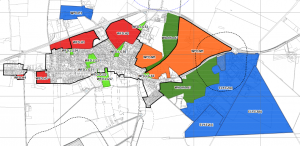East Cambridgeshire District Council approved the final draft of its Local Plan at its meeting on 5 October. In a sudden last-minute change, major site WFD.M1 in Witchford was deleted from the plan, with a revised recommendation circulated round the table without notice.
WFD.M1 is the large site in orange on the map, split in two by a thin green wedge, spreading from the Lancaster Way roundabout west into Witchford. It was put forward late in the local plan process by the Church Commissioners, who own the land. There was consequently much less opportunity for local residents to give their views on its inclusion.
The site was proposed for 720 houses, a massive increase in a village like Witchford. It was also intended to include a school, though the relationship between this and the existing Rackham school was not clear.
The deletion of the site is excellent news for residents and for Witchford Parish Council, who have campaigned vigorously against it.
The draft Local Plan needed to allocate land for 8,933 dwellings, but in fact allocated well in excess of this, a total of 10,490 dwellings. Although this was not stated, the deletion of WFD.M1 presumably means that this excess of 1,557 is almost halved to 837. No additional sites have been included to compensate for the removal of the 720 dwellings at WFD.M1. This can only mean that the district council will have to work very much harder to ensure that the dwellings remaining in the plan are actually built.
What next? The latest draft of the Local Plan, without WFD.M1, will be opened to public consultation in November for six weeks. After that, the plan and public comments will be handed to the planning inspector, who will hold a public inquiry into the draft plan next year. The plan is expected to be finally approved in autumn 2018.
The rules for responding to the draft Local Plan at this stage are much more restrictive than at previous stages. Further information here in due course.
For the record, despite the welcome deletion of WFD.M1, I voted against the draft plan. I have always maintained that spreading growth in small pockets everywhere was likely to lead to unsustainable developments without access to good (or even any) public transport, and to make it difficult to ensure sufficient infrastructure. It is clear the council needed a ‘fix’ to overcome the failure of its current Local Plan and the resulting ‘Klondike’ of speculative planning applications. But we will have to live with the proposals in the Local Plan for decades to come, and it isn’t something we can afford to get wrong.

